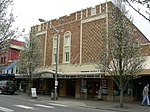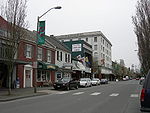Skagit City, Washington
Skagit City was a town on the western bank of the South Fork Skagit River, less than a mile southeast of where the river forks north and south, in the U.S. state of Washington. The Barker's Trading Post along the river, opened in 1869, was partially or fully responsible for drawing people to settle at the townsite, which became an important river transportation center during the late 1800s, most notably in 1872. The city prospered until shortly before the 1880s, after river access to the upstream community of Mount Vernon, Washington was established and Mount Vernon began to prosper. By 1906, only one business remained in the entire town, and soon after World War II the town disappeared entirely. Today, the unincorporated community of Cedardale is the closest community to the former townsite at 2.4 miles (3.9 km) distance, and the name "Skagit City" has become simply a placename on the northeastern tip of Fir Island near where two distributaries diverge and carry Skagit River water into Skagit Bay, which branches off the Strait of Juan de Fuca. Skagit City is sometimes confused with the nearby tiny hamlet of Skagit Forks, which was just to the northwest at the divergence of the North and South Forks of the Skagit River. The town played an integral part in the settlement of Skagit County.
Excerpt from the Wikipedia article Skagit City, Washington (License: CC BY-SA 3.0, Authors).Skagit City, Washington
Skagit City Road,
Geographical coordinates (GPS) Address Nearby Places Show on map
Geographical coordinates (GPS)
| Latitude | Longitude |
|---|---|
| N 48.383333333333 ° | E -122.36305555556 ° |
Address
Skagit City Road
Skagit City Road
98238
Washington, United States
Open on Google Maps








